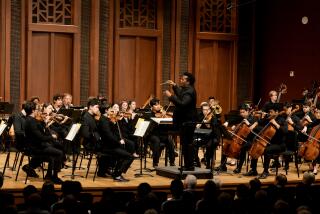Wayne Shorter Reemerges With Tantalizing Harmony
- Share via
Wayne Shorter has been a highly regarded jazz artist for more than four decades--and with good cause.
Initially, his favorable impact was associated with the fact that he was one of the few tenor saxophonists to sustain his own style during the John Coltrane-influenced ‘60s and beyond. Later, in his compositions for the classic Miles Davis quintet of the ‘60s, his work with Weather Report and his own innovative albums, he established himself as an important force in identifying new ways to organize, construct and interpret the jazz experience.
Aside from a series of performances--and a recording--in which he explored the world of spontaneous improvisation with longtime friend and musical companion Herbie Hancock, Shorter has maintained a relatively low visibility since the death of his wife, Ana Maria, in the explosion of TWA Flight 800 in 1996 (he has since remarried).
But on Friday, at USC’s Bovard Auditorium, he provided a tantalizing view of a project that will reach its full fruition in a new recording scheduled for release in 2001. Performing with the all-student Thornton Symphony, conducted by Robert Sadin, Shorter was the principal soloist in large-scale renderings of four of his original compositions: “Angola,” “Orbits,” “Capricorn II” and “Syzygy.”
The results, despite limited rehearsal time, were extraordinary. Shorter’s music is notable for its harmonic richness and--more than that--the manner in which he organizes and voices his chords. His orchestrations for full orchestra--not exactly something he has done on an everyday basis--were lush, well-crafted and communicative, tinged with Impressionistic touches yet flowing with the ease of a small jazz group.
And the youthful Thornton Symphony, meticulously guided by Sadin, did a superb job of navigating their way through the music’s tricky harmonic shoals.
Shorter’s soloing, on both tenor and soprano saxophones, unfolded with the mysterious qualities that have characterized his playing for the past few years. Often suspended above the orchestra’s textures, sometimes elusively intimate, always intensely personal, his lines provided the perfect counterpoint to the layered densities of the orchestral sounds.
He was also accompanied, in the orchestral segments as well as during an opening set, by a superb quintet that included pianist Brad Mehldau, bassist John Patitucci, drummer Terri Lyne Carrington and percussionist Alex Acuna.
More to Read
The biggest entertainment stories
Get our big stories about Hollywood, film, television, music, arts, culture and more right in your inbox as soon as they publish.
You may occasionally receive promotional content from the Los Angeles Times.









